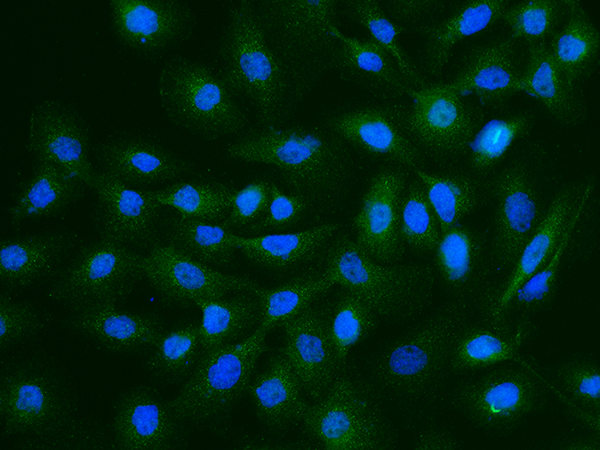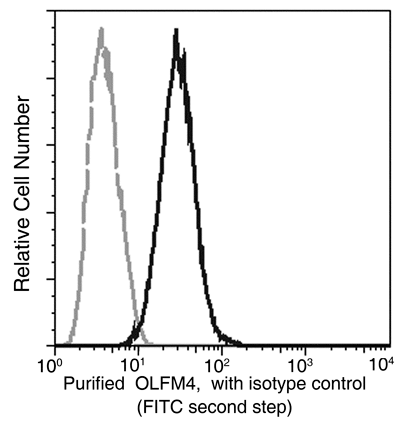-
Product Name
Anti-OLFM4/GW112 antibody
- Documents
-
Description
Mouse monoclonal to OLFM4/GW112
-
Tested applications
ELISA, FCM, IF, ICC/IF
-
Species reactivity
Human OLFM4 / GW112
-
Alternative names
bA209J19.1 antibody; GC1 antibody; GC1 antibody; Gm296 antibody; Gm913 antibody; GW112 antibody; GW112 antibody; hGC-1 antibody; hOLfD antibody; KIAA4294 antibody; OlfD antibody; OlfD antibody; OLFM4 antibody; OLFM4 antibody; OLM4 antibody; OLM4 antibody; pPD4 antibody; UNQ362 antibody; UNQ362/PRO698 antibody; GC1 antibody; OLM4 antibody; OlfD antibody; GW112 antibody; hGC-1 antibody; hOLfD antibody; UNQ362 antibody; bA209J19.1 antibody; GC1 antibody; OlfD antibody; pPD4 antibody; GW112 antibody; Gm296 antibody; Gm913 antibody
- Immunogen
-
Isotype
Mouse IgG1
-
Preparation
This antibody was produced from a hybridoma resulting from the fusion of a mouse myeloma with B cells obtained from a mouse immunized with purified, recombinant Human OLFM4 / GW112 (rh OLFM4 / GW112; NP_006409.3; Met 1-Gln 510).
-
Clonality
Monoclonal
-
Formulation
0.2 μm filtered solution in PBS with 5% trehalose
-
Storage instructions
This antibody can be stored at 2℃-8℃ for one month without detectable loss of activity. Antibody products are stable for twelve months from date of receipt when stored at -20℃ to -80℃. Preservative-Free.
Sodium azide is recommended to avoid contamination (final concentration 0.05%-0.1%). It is toxic to cells and should be disposed of properly. Avoid repeated freeze-thaw cycles. -
Applications
ELISA: 0.5-1 μg/mL
This antibody can be used at 0.5-1 μg/mL with the appropriate secondary reagents to detect Human OLFM4.
FCM: 0.5-2 μg/Test
ICC/IF: 10-25 μg/mL
-
Validations

OLFM4 / GW112 Antibody, Mouse MAb, Immunofluorescence
Immunofluorescence staining of Human OLFM4 in A431 cells. Cells were fixed with 4% PFA, permeabilzed with 0.3% Triton X-100 in PBS, blocked with 10% serum, and incubated with Mouse anti-Human OLFM4 monoclonal antibody (15 µg/ml) at 37℃ 1 hour. Then cells were stained with the Alexa Fluor® 488-conjugated Goat Anti-mouse IgG secondary antibody (green) and counterstained with DAPI (blue). Positive staining was localized to cytoplasm.

OLFM4 / GW112 Antibody, Mouse MAb, Flow cytometric
Flow cytometric analysis of Human OLFM4 expression in DU145 cells. The cells were treated according to manufacturer’s manual (BD Pharmingen™ Cat. No. 554714), and stained with Purified Mouse anti-OLFM4 (11639-MM12, 1 μg/test), then a FITC-conjugated second step antibody. The fluorescence histograms were derived from gated events with the forward and side light-scatter characteristics of intact cells.
-
Background
Olfactomedin-4, also known as G-CSF-stimulated clone 1 protein, Antiapoptotic protein GW112, and OLFM4, is a secreted protein which contains one olfactomedin-like domain. The OLFM4 gene was recently reported to inhibit various apoptotic pathways and promote proliferation of cancer cells, suggesting that OLFM4 might serve as a diagnostic marker for human cancers. Thus, OLFM4 mRNA might be a useful tool to support the diagnosis of cancer, irrespective of the clinical stages. It is overexpressed in a number of human tumor types, especially in those of the digestive system. GW112 is associated with GRIM-19, a protein known to be involved in regulating cellular apoptosis. Functionally, GW112 could significantly attenuate the ability of GRIM19 to mediate retinoic acid-IFN-beta-mediated cellular apoptosis and apoptosis-related gene expression. In addition, GW112 demonstrated strong antiapoptotic effects in tumor cells treated with other stress exposures such as hydrogen peroxide. Finally, forced overexpression of GW112 in murine prostate tumor cells led to more rapid tumor formation in a syngeneic host. OLFM4 is an important regulator of cell death that plays important roles in tumor cell survival and tumor growth. As a candidate gene for cancer-specific expression. The serum olfactomedin 4 (OLFM4) is a useful marker for Gastric cancer (GC) and its measurement alone or in combination with Reg IV has utility in the early detection of GC. GW112 has an antiapoptotic property against the cytotoxic agents-induced apoptosis. It suggested that GW112 could be an important mediator in NF kappaB-dependent tumorigenesis of digestive tract tissues.
-
References
- Zhang X, et al. (2004) GW112, a novel antiapoptotic protein that promotes tumor growth. Cancer Res. 64(7): 2474-81.
- Koshida S, et al. (2007) Specific overexpression of OLFM4(GW112/HGC-1) mRNA in colon, breast and lung cancer tissues detected using quantitative analysis. Cancer Sci. 98(3): 315-20.
- Oue N, et al. (2009) Serum olfactomedin 4 (GW112, hGC-1) in combination with Reg IV is a highly sensitive biomarker for gastric cancer patients. Int J Cancer. 125(10): 2383-92.
- Kim KK, et al. (2010) Up regulation of GW112 Gene by NF kappaB promotes an antiapoptotic property in gastric cancer cells. Mol Carcinog. 49(3): 259-70.
Related Products / Services
Please note: All products are "FOR RESEARCH USE ONLY AND ARE NOT INTENDED FOR DIAGNOSTIC OR THERAPEUTIC USE"
